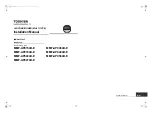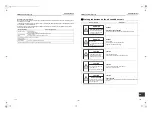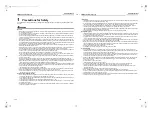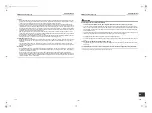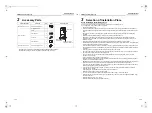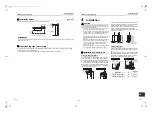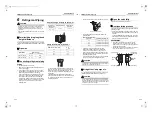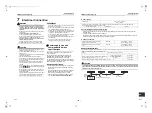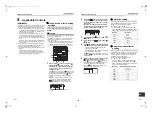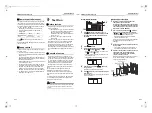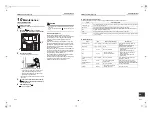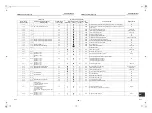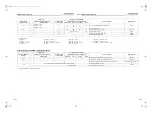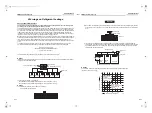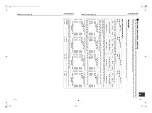
– 9 –
SMMS Floor Standing Type
Installation Manual
SMMS Floor Standing Type
Installation Manual
6
Refrigerant Piping
CAUTION
When the refrigerant pipe is long, provide support
brackets at intervals of 2.5 m to 3 m to clamp the
refrigerant pipe. Otherwise, abnormal sound may be
generated.
Use the flare nut attached with the indoor unit or R410A
flare nut.
Permissible piping length and
height difference
They vary depending on the outdoor unit. For details,
refer to the Installation Manual attached to the outdoor
unit.
Pipe size
Connecting refrigerant piping
Flaring
1. Cut the pipe with a pipe cutter.
Remove burrs completely. (Remaining burrs may
cause gas leakage.)
2. Insert a flare nut into the pipe, and flare the pipe.
Use the flare nut provided with the unit or the one
used for the R410A refrigerant. The flaring
dimensions for R410A are different from the ones
used for the conventional R22 refrigerant. A new
flare tool manufactured for use with the R410A
refrigerant is recommended, but the conventional
tool can still be used if the projection margin of the
copper pipe is adjusted to be as shown in the
following table.
Projection margin in flaring: B (Unit: mm)
Flaring diameter size: A (Unit: mm)
* In case of flaring for R410A with the conventional
flare tool, pull it out approx. 0.5 mm more than that
for R22 to adjust to the specified flare size. The
copper pipe gauge is useful for adjusting projection
margin size.
• The sealed gas was sealed at the atmospheric
pressure so when the flare nut is removed, there will
no “whooshing” sound: This is normal and is not
indicative of trouble.
Model MMF-
Pipe size (mm)
Gas side
Liquid side
AP015 to AP018
Ø12.7
Ø6.4
AP024 to AP056
Ø15.9
Ø9.5
Outer dia. of
copper pipe
R410A tool used
Conventional
tool used
6.4, 9.5
0 to 0.5
1.0 to 1.5
12.7, 15.9
Outer dia. of copper pipe
A +0
–0.4
6.4
9.1
9.5
13.2
12.7
16.6
15.9
19.7
• Use two wrenches to connect the indoor unit pipe.
• Use the tightening torque levels as listed in the
following table.
• Tightening torque of flare pipe connections.
Pressure of R410A is higher than that of R22.
(Approx. 1.6 times) Therefore, using a torque
wrench, tighten the flare pipe connecting sections
which connect the indoor and outdoor units of the
specified tightening torque.
Incorrect connections may cause not only a gas leak,
but also a trouble of the refrigeration cycle.
CAUTION
Tightening with an excessive torque may crack the nut
depending on installation conditions.
Airtight test / air purge, etc.
For air tightness test, adding refrigerant, refer to the
Installation Manual attached to the outdoor unit.
CAUTION
Do not supply power to the indoor unit until the airtight
test and vacuuming are completed. (If the indoor unit is
powered on, the pulse motor valve is fully closed, which
extends the time for vacuuming.)
Open the valve fully
Open the valve of the outdoor unit fully.
Heat insulation process
Apply heat insulation for the pipes separately at liquid
side and gas side.
• For the heat insulation to the pipes at gas side, use
the material with heat-resisting temperature 120 °C
or higher.
• To use the attached heat insulation pipe, apply the
heat insulation to the pipe connecting section of the
indoor unit securely without gap.
REQUIREMENT
• Apply the heat insulation to the pipe connecting
section of the indoor unit securely up to the root
without exposure of the pipe. (The pipe exposed to the
outside causes water leak.)
• Insulate the refrigerant pipe in the indoor unit securely
up to the point shown in the following figure.
Outer dia. of connecting
pipe (mm)
Tightening torque (N•m)
6.4
14 to 18 (1.4 to 1.8 kgf•m)
9.5
33 to 42 (3.3 to 4.2 kgf•m)
12.7
50 to 62 (5.0 to 6.2 kgf•m)
15.9
63 to 77 (6.3 to 7.7 kgf•m)
Work using double spanner
Adhesive tape
Banding
band
Attached heat
insulated pipe
Gas side piping
Liquid side piping
Banding
band
17-EN
18-EN
+00EH99880501_01EN.book Page 9 Thursday, April 7, 2011 10:15 AM

